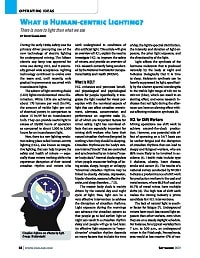Mining Publication: What is Human-centric Lighting?
Original creation date: October 2021
Authors: J Sammarco
Coal Age 2021 Sept; 126(7):26-27
During the early 1900s, safety was the primary driver prompting use of the new technology of electric lighting for underground mining. The Edison electric cap lamp was approved for mine use during 1915, and it eventually gained wide acceptance. Lighting technology continued to evolve over the years and, until recently, only gradual improvements occurred with incandescent lights.
The advent of light emitting diode (LED) lights revolutionized mine illumination. White LEDs are achieving about 170 lumens per watt (lm/W), the amount of visible light per unit of electrical power, in comparison to about 15 lm/W for an incandescent bulb. They can provide useful light in excess of 50,000 hours of operation as compared to about 1,000 to 3,000 hours for an incandescent light.
Now, there is a new lighting revolution taking place called human-centric lighting (HCL), also known as integrative lighting, that can help improve the safety and health of miners—especially those miners working shifts who experience disruption of their natural circadian rhythm and miners who work underground in conditions of dim artificial light. This article will give an overview of HCL, explain the need to investigate HCL to improve the safety of miners, and provide an overview of HCL research currently being conducted by the National Institute for Occupational Safety and Health (NIOSH).

Coal Age 2021 Sept; 126(7):26-27
- Computer Design and Evaluation Tool for Illuminating Underground Coal-Mining Equipment
- Discomfort Glare Comparison for Various LED Cap Lamps
- Human-centric Lighting for Mitigating Mineworker Circadian Disruption and Improving Well-being
- Identification of Potential Roof Problems Using LED Lighting & Numerical Modeling of Highwall Stability Using FLAC3D
- Illumination
- Infographic: Shine More Light on Hazards
- LED Lighting for Improving Trip Object Detection for a Walk-thru Roof Bolter
- NIOSH Saturn Area Light
- The Potential Impact of Light Emitting Diode Lighting on Reducing Mining Injuries During Operation and Maintenance of Lighting Systems
- Technology News 556 - The NIOSH LED Cap Lamp Provides Improved Illumination for Greater Safety in Underground Mines